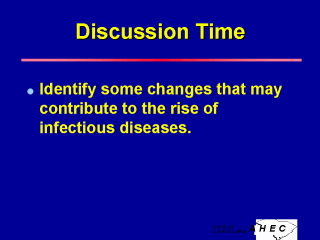| front |1 |2 |3 |4 |5 |6 |7 |8 |9 |10 |11 |12 |13 |14 |15 |16 |17 |18 |19 |20 |21 |22 |23 |24 |25 |26 |27 |28 |29 |30 |31 |32 |33 |34 |35 |review |
 |
Answers may include the following modern demographic and environmental factors that favor the spread of infectious diseases: Environment (technology and industry ) International travel and commerce, global travel, globalization of the food supply and centralized processing of food; worldwide transport of animals and food products. Population growth and increased urbanization and crowding; poverty; population movements due to civil wars, famines, and other man-made or natural disasters; migration. Economic development and land use; irrigation, deforestation and reforestation projects that alter the habitats of disease carrying insects and animals. Microbial adaptation:development of resistance to newly emerging microbes. Human behaviors, such as IV drug use and risky sexual behavior; increased use of antimicrobial agents and pesticides, hastening the development of resistance; and increased human contact with tropical forests and other wilderness habitats that are reservoirs for insects and animals that harbor unknown infectious agents; increasing numbers of persons with impaired host defenses. USDHHS (1998), Preventing Emerging Infectious Diseases: A Strategy for the 21st Century, Atlanta: Centers for Disease Control and Prevention. |
| front |1 |2 |3 |4 |5 |6 |7 |8 |9 |10 |11 |12 |13 |14 |15 |16 |17 |18 |19 |20 |21 |22 |23 |24 |25 |26 |27 |28 |29 |30 |31 |32 |33 |34 |35 |review |